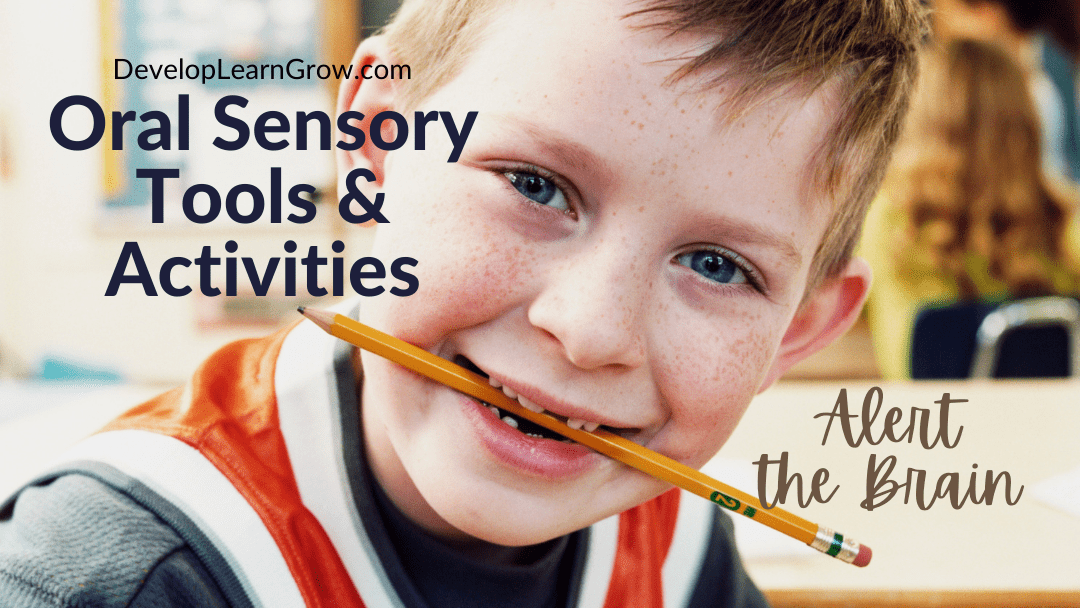Know of any kids (or adults) who chew on items when they’re stressed or trying to concentrate? Oral sensory activities and specific snacks and tools for the mouth help kids stay focused when doing school work.
To answer the question above… I’m sure you know of at least one chewer! Or maybe a whole bunch!
Children’s nervous systems are less mature, so you may be thinking of the kiddo chewing on a shirt sleeve, shirt collar, or fingernails.
Adults can be a little more subtle (hopefully) and go for a daily piece of gum or maybe a pen cap.
These oral sensory activities are important. Maybe even necessary for some people!
And for others, they can increase alertness when mental fatigue sets in.
How Do Oral Sensory Activities Help with Learning?
Oral sensory behaviors are the nervous system’s natural way to self-regulate. It gives input that’s CALMING and ORGANIZING for the brain.
Babies are calmed by bottles, pacifiers, and thumbs. As they grow, they mouth everything! The brain gains so much info as the hands and mouth explore toys.
The sensory receptors in the hands and mouth take up a large amount of “real estate” in the brain. So, it gives tons of info to a large area of the brain.
Especially for the size of our mouths (and hands) compared to the rest of the body.
The receptors receive touch input in and around the mouth (texture, temperature.) They also receive pressure (proprioceptive) input through the jaw, tongue and roof of the mouth.

Hence, all the chewing!
The pressure of the thumb on the roof of the mouth and the movement and feeling of the tongue suckling is so calming for little ones!
In addition to touch and pressure input, our mouth has taste buds. Certain tastes give additional input that wakes up the brain.
The oral sensory input is not only calming and organizing but it can be alerting for the brain.
Oral sensory activities, snacks and tools help with focusing and concentrating.
Oral Sensory Activities and Tools to Help Kids stay Focused
The following tips are organized into oral sensory snacks / beverages and activities / tools for the mouth.
They all provide alerting and organizing input for the brain! So important when your kiddo needs an extra boost to stay focused.
Please use caution with when offering some of the snack ideas or tools. Choose items that are safe and that you know they can handle well!
Offer the food items as part of meals or for snacks. Use straws and cold drinks throughout the school day when possible and when doing homework. Tools and activities can be used if extra input is needed!
[This post contains affiliate links. See below for more information.]

Oral Sensory Snacks and Beverages
- Chewy: dried fruits (raisins, prunes, apricots, etc), chewy granola, fig bars, fruit strips, jerky, gum (try two pieces if more input is needed!)
- Crunchy: dehydrated fruits or dried beans, raw veggies (carrots, beans, snap peas, pepper strips, cucumbers, radishes), pita / Naan chips, hard granola, dry cereal, nuts / seeds
- Cold: ice chips, frozen fruit (or even veggies such as peas!), iced water / iced drinks, frozen yogurt / avocado / oatmeal PB energy bites, popsicles, frozen yogurt
- Straws: “Drink” purees – use thin or medium straws to drink applesauce, yogurt, smoothies, shakes
- Drinks: carbonated water, lemon water, iced water, use long squiggly straws to increase the effort!
- Add natural flavors to foods: lemon, lime, cinnamon, ginger, nutmeg, dried herbs, garlic, vinegar, pepper, spices as tolerated
- Hard sugar free candies, or for an occasional special treat: lollipops or intense hard candy flavors (sour, citrus, hot cinnamon)
Activities and Tools
- Chew on straws, coffee stirrers, or rubber tubing when needing to concentrate (check out these chewable gnaw straws)
- Take a break to press tongue to roof of mouth
- Use a straw to suck up letter cards for a matching game (or spell a word)
- Use a straw to suck up number card for counting or math problems
- Bite a tongue depressor or popsicle stick, hang sight words or vocab words from it to remove and study
- Move tongue around teeth (bottom inside -> outside, top outside -> inside, reverse directions!)
- Take a deep breath, seal lips together and blow cheeks out, hold; slowly release air through lips
- Make faces (pursed / fish lips, frown, big smile, surprise face)
- Massage and stretch cheeks and lips
- Party blow-outs, harmonicas, string pipes or soft whistle toys (lip whistles are one of my favorites)
- Whistle or hum a song
- Chewable pencil toppers such as Textured Pencil Toppers
- Chewelry necklaces (several other options are available on the site)
- For kiddos who prefer cloth / clothing: these Bite Bands are super absorbent and washable
For More Information
If you’re concerned about your child chewing on non-desired items too often, and the tools above aren’t enough, check out Your Kids’ Table’s Everything Oral Sensory: The Total Guide. The author is another OT who explains challenges with oral behaviors and gives additional tips and tools.
Pin this to Pinterest or share with anyone who may find this info helpful.
(Also, these tips can help adults! Share with anyone who is struggling to focus at work. These strategies are proven to be effective!)
Related Posts:
As an Amazon Associate, Develop Learn Grow may earn a small commission from the Amazon link. Other affiliate links are included in this post as well (Fun and Function) for your convenience. See full disclaimer and privacy policy for more information.]








0 Comments